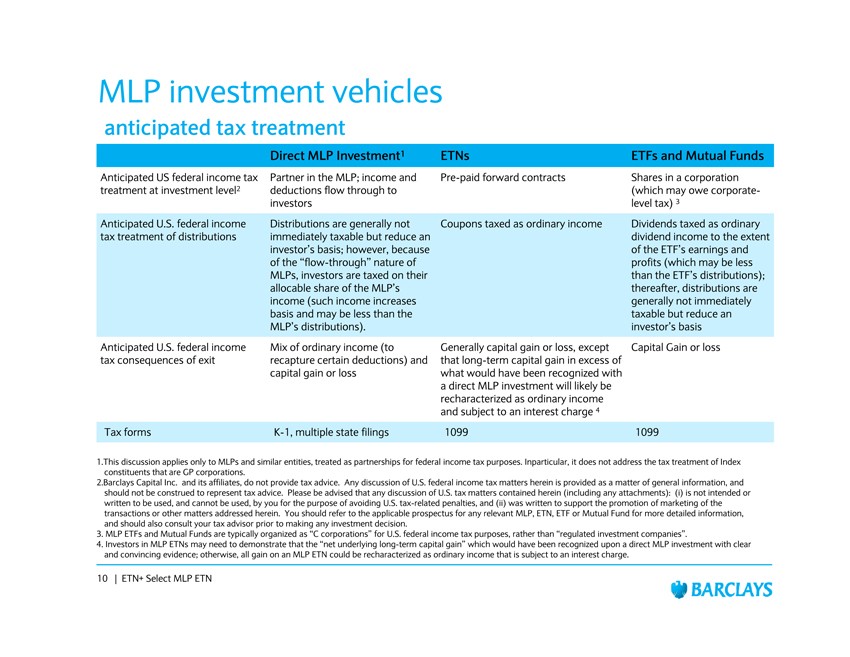MLPs and Taxation A Quick Refresher for Tax Season Investing Daily
Post on: 30 Июль, 2015 No Comment

Master Limited Partnerships (MLP) dont pay any tax at the corporate level, provided their activities are considered qualified. Instead, quarterly distributions are passed directly to unitholders (investors); investors pay individual tax on their distributions. But MLP distributions are highly tax-advantaged and offer a significant tax shield for investors.
Because MLP distributions arent dividends, MLP unitholders dont get a Form 1099 at tax time. Instead, unitholders receive a form K-1a standard partnership form thats typically mailed to unitholders in March.
But there are some big tax benefits to owning MLPs. Because of depreciation allowance, 80 to 90 percent of the distribution you receive from a typical MLP is considered a return of capital by the IRS. You dont pay taxes immediately on this portion of the distribution.
Instead, return of capital payments serve to reduce your cost basis in the MLP. Youre not taxed on the return of capital until you sell the units.
In other words, 80 to 90 percent of the distribution you receive from the MLP is tax-deferred. The remaining piece of each distribution is taxed at normal income tax rates, not the special dividend tax rate. But the piece taxed at full income tax rates is only 10 to 20 percent of the total distribution; theres still a huge deferred tax shield for unitholders.
An example can provide a useful illustration. Assume you own an MLP purchased for $50 and receive $5 in annual distribution payments, $4.50 of which is considered a return of capital. After one year, your cost basis on the MLP would drop to $45.50 ($50 minus $4.50); no income tax is paid on that $4.50. Youd pay normal income tax rates on the remaining 50 cents.
When you finally sell the units or the cost basis drops to zero dollars, a portion of the capital gains are taxed at the special long-term capital gains tax rate. The remainder is taxed at your full income tax rate. But in most cases, MLPs should be held for long periods to get the full benefit of distributions. Youre likely to be deferring 80 to 90 percent of your taxes for several years or perhaps indefinitelya tremendous benefit for most investors.
Many investors find the term return of capital confusing.
This is simply a tax term; it doesnt mean that the partnership is literally giving you back your investment. MLPs are pass-through entities: For tax purposes only, its as though unitholders generated the partnerships earnings for themselves. Net income generated by the MLP is allocated proportionally among individual investors.
In addition to income MLPs are also able to pass-through other deductions and tax credits such as depreciation. It is these passed-through tax credits that generate tax-deferred return of capital.
This is also one reason that earnings are next-to-meaningless for MLPs and LLCs. Standard earnings measures include a large number of non-cash chargesaccounting entries that dont have a real impact on cash the partnership receives in the course of doing business.
Examples include depreciation and depletion allowances. In many cases, MLPs try to maximize such non-cash charges because these are the very charges that allow investors to treat distributions as return of capital.
A more meaningful measure of earnings power for partnerships is distributable cash flow (DCF). To calculate DCF, add all non-cash charges back into the earnings figures and then subtract a measure known as maintenance capital. Maintenance capital is simply a measure of the total cash investment needed each year to maintain an MLPs assets in good working order.
If you prepare your own tax returns, MLPs do add a level of complication to annual tax preparation but any additional complexity is well worth it to garner the tax advantages of investing in the group. And the good news is that the Schedule K-1 and accompanying documentation have become clearer in recent years.
Some of the major MLPs will even allow you to download data from your K-1 directly into a tax preparation program such as TurboTax. All MLPs and LLCs also have special K-1 help lines you can call at tax time if you need assistance preparing your return or have a question about how to fill out the required forms.
The important point to note is that the K-1 packet you receive contains all of the information you need to complete your return. The Schedule K-1 itself contains numbered boxes; software packages such as TurboTax will walk you through exactly where to enter the numbers in each of these boxes.

There are two additional considerations. First, if you sold units of the MLP in a particular tax year you will need to know what your cost basis on the MLP is, adjusted for all return of capital payments received over the life of the investment. While its always a good idea to keep records, its not totally necessary as the K-1 Packet you receive contains all of this information including the dates you bought units, how much you paid and the income you received over time.
Second, one common push-back you will hear about investing in MLPs is that youre required to file taxes in every state in which the MLP operates. Thats only partially true.
It is true that when you own an MLP you are considered to be earning income in every state in which that MLP operates. However, in most cases unless you own a large position in the MLP its likely you will not have to file a return in every state or pay any state taxes outside your home state. There are two main reasons for this.
First, many key states in which MLPs operate dont have state income taxes at all. Examples include Texas and Wyoming, both xtates where MLPs are extremely active.
Most others have minimum income limits; unless you have income from the MLP above that limit youre not required to file state taxes.
As most MLPs operate in multiple states, the share of income allocable to each individual State is quite small; typically only investors with large holdings will need to file. The exact amount of income allocable to each individual State is included in your K-1 form.
The benefits of tax deferral coupled with high current income outweigh these complications. And many find it easier to simply consult a tax professional; any good accountant can easily handle MLPs.
Editors note: Elliott Gue and Roger Conrad give away 6 free MLP stock picks in their special report, The Best MLP Investments to Own Now .














